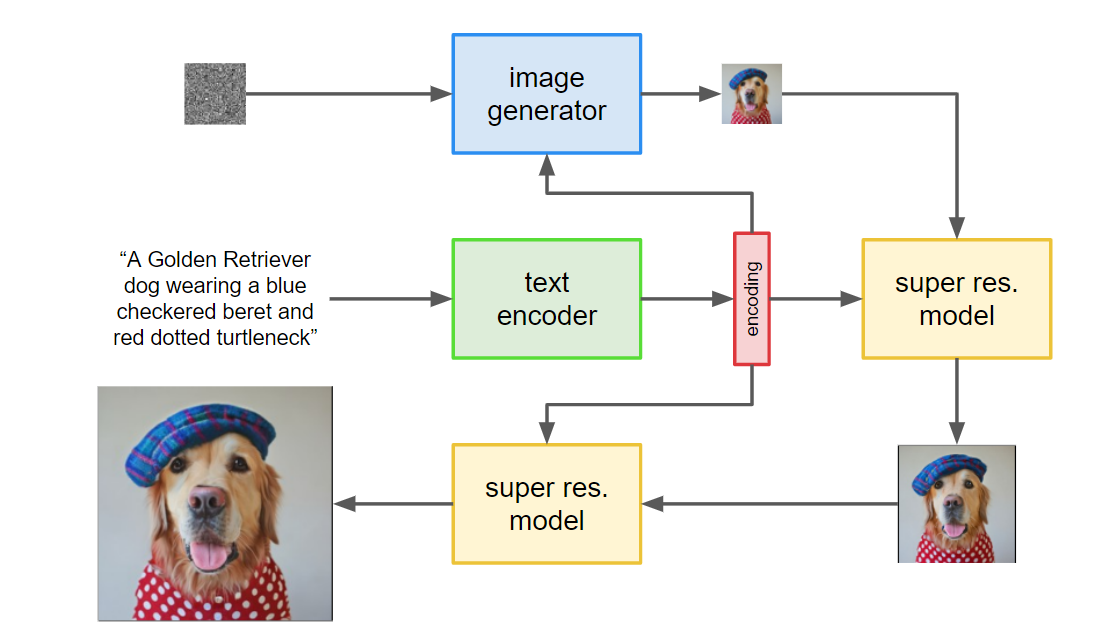MinImagen
A Minimal implementation of the Imagen text-to-image model.
For a tutorial on building this model, see here.
Given a caption of an image, Imagen will generate an image that reflects the caption. The model is a simple cascading diffusion model, using a T5 text encoder to encode the captions which conditions a base image generator, and then a sequence of super-resolution models.
In particular, two notable contributions are the developments of:
- Noise Conditioning Augmentation, which noises low-resolution conditioning images in the super-resolution models, and
- Dynamic Thresholding which helps prevent image saturation at high classifier-free guidance weights.
See How Imagen Actually Works for a detailed explanation of Imagen's operating principles.
Attribution Note
This implementation is largely based on Phil Wang's Imagen implementation.
Installation
$ pip install minimagenIn order to use the training.py file, you will also need to install datasets and nonechucks:
$ pip install nonechucksNote that MinImagen requires Python3.9 or higher
Documentation
Documentation can be found here
Usage
A minimal usage:
import torch
from minimagen.Imagen import Imagen
from minimagen.Unet import Unet, Base, Super
from minimagen.t5 import t5_encode_text, get_encoded_dim
from torch import optim
# Name of the T5 encoder to use
encoder_name = 't5_small'
# Text captions of training images
train_texts = [
'a pepperoni pizza',
'a man riding a horse',
'a Beluga whale',
'a woman rock climbing'
]
# Training images (side length equal to Imagen final output image size)
train_images = torch.randn(4, 3, 64, 64)
# Create the Imagen instance
enc_dim = get_encoded_dim(encoder_name)
unets = (Base(text_embed_dim=enc_dim), Super(text_embed_dim=enc_dim))
imagen = Imagen(unets=unets, image_sizes=(32, 64), timesteps=10)
# Create an optimzier
optimizer = optim.Adam(imagen.parameters())
# Train the U-Nets in Imagen
for j in range(10):
for i in range(len(unets)):
optimizer.zero_grad()
loss = imagen(train_images, texts=train_texts, unet_number=i)
loss.backward()
optimizer.step()
# Sample captions to generate images for
sample_captions = [
'a happy dog',
'a big red house',
'a woman standing on a beach',
'a man on a bike'
]
# Generate images
images = imagen.sample(texts=sample_captions, cond_scale=3., return_pil_images=True)
# Save images
for idx, img in enumerate(images):
img.save(f'Generated_Image_{idx}.png')Text embeddings and masks can be precomputed, and Unets parameters can be specified rather than using Base and Super:
train_encs, train_mask = t5_encode_text(train_texts, name=encoder_name)
enc_dim = get_encoded_dim(encoder_name)
base_unet = Unet(
dim=32,
text_embed_dim=enc_dim,
cond_dim=64,
dim_mults=(1, 2, 4),
num_resnet_blocks=2,
layer_attns=(False, False, True),
layer_cross_attns=(False, False, True),
attend_at_middle=True
)
super_res_unet = Unet(
dim=32,
text_embed_dim=enc_dim,
cond_dim=512,
dim_mults=(1, 2, 4),
num_resnet_blocks=(2, 4, 8),
layer_attns=(False, False, True),
layer_cross_attns=(False, False, True),
attend_at_middle=False
)
# Create Imagen instance
imagen = Imagen((base_unet, super_res_unet), image_sizes=(32, 64), timesteps=10)